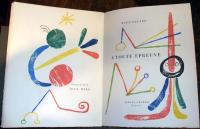This spring, we are celebrating the fiftieth anniversary of À toute épreuve, one of the most beautiful books of the twentieth century, created by the French poet Paul Éluard and the Catalan artist Joan Miró. The entire unbound volume is on exhibit in the Milberg Gallery for the Graphic Arts, Firestone Library, through June 29, 2008.
The exhibition opening will be celebrated on Sunday, March 9, 2008, with Elza Adamowicz, Professor of French and Visual Culture, School of Modern Languages, Queen Mary, University of London, presenting the talk “The Surrealist Artist’s Book: Beyond the Page” in the Betts Auditorium, School of Architecture, at 3:00. A reception will follow at 4:00, in the Leonard L. Milberg Gallery for the Graphic Arts on the second floor of Firestone Library.

épreuve. Gravures sur bois de
Joan Miró. Première édition
illustrée. Geneva: Gérald Cramer, [1958]. 79 woodcuts by Joan Miró, printed in Paris at Atelier
Lacourière; text printed by Marthe Fequet and Pierre Baudier. Image: © 2008 Successió Miró / Artists Rights Society (ARS), New York / ADAGP, Paris
From its humble beginnings in 1930 as a plain paper miniature, this simple collection of poems was transformed into an extraordinary deluxe edition folio. The cries of loneliness expressed in Éluard’s verse, “Je suis seul je suis seul tout seul” (I am alone I am alone all alone), are answered on each page with the buoyant companionship of vibrantly colored prints, resulting in a new sense of wholeness and optimism. The title of the work, roughly translatable as “ready for anything” or “foolproof,” conveys a sense of durability and perseverance. Éluard’s poems represent strength in the face of emotional turmoil just as the book survived production challenges and setbacks to become a monument to the art of bookmaking and the possibilities of collaboration.
The project began in 1947, when the Swiss publisher Gérald Cramer approached Éluard with the idea of publishing an illustrated edition of his poetry. For the art, Éluard suggested his friend Miró, with whom he had already collaborated. It took Miró eleven years to create the 233 blocks needed to print 79 woodcuts. He used planks of wood collaged with plastic, wire, old engravings and bark paper to achieve images that practically dance across the page. “I am completely absorbed by the damn book,” wrote Miró to his publisher, Gerald Cramer, “I hope to create something sensational… .” The final volume has a brilliance of invention and a vitality of form and color, rarely found inside the cover of a book.
Special thanks go to Ainsley Brown, Ph.D. candidate, Department of French and Italian, for her work on all aspects of this exhibition and its keepsake. In the gallery, we will offer English language translations of the poetry, some by Ms. Brown and some by the Irish writer Samuel Beckett, who was a great admirer of Eluard’s work. Here is a sample:
| L’univers-Solitude 2 Villages de la lassitude Où les filles ont les bras nus Comme des jets d’eau La jeunesse grandit en elles Et rit sur la pointe des pieds. Villages de la lassitude Où tous les êtres sont pareils. Paul Eluard | Universe-Solitude 2 Villages of weariness Where the arms of girls are bare As jets of water Where their youth increasing in them Laughs and laughs and laughs on tiptoe. Villages of weariness Where everybody is the same Translation by Samuel Beckett |
